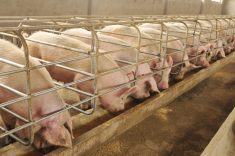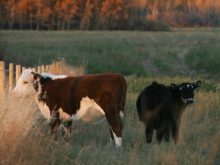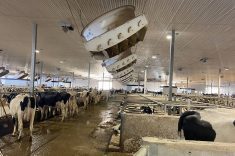What if there was a solar-powered gadget that would cruise pastures, eat pesky leafy spurge and eject it out the back as fertilizer?
Of course, sheep and goats eat spurge, but in many cases problems such as predators can prevent them from being used.
Cattle, on the other hand, can be trained to eat weeds, says animal behaviorist Kathy Voth.
The secret lies in rewiring their brains to try new food.
“It’s not magic,” the Colorado-based founder of Livestock for Landscapes told the Manitoba Grazing School.
Read Also

VIDEO: British company Antler Bio brings epigenetics to dairy farms
British company Antler Bio is bringing epigenetics to dairy farms using blood tests help tie how management is meeting the genetic potential of the animals.
“There are no tricks. You just have to think a little bit differently about your animals.”
One thing is for sure, she said: the alternative doesn’t work.
Ranchers in the United States spend $5 billion a year on pasture and rangeland weed control.
North of the border, things aren’t going well either.
“Canada put together the very first legislation for the control and eradication of a weed. That was the1865 Canada Thistle Eradication Act. How’s that going for you so far?” she joked.
“If the definition of insanity is doing the same thing over and over again and expecting different results, what does that say about all of us?”
Voth was first inspired to train cows to eat weeds in 1997 when she saw a picture of a steer eating a dead rabbit.
The steer, which had been grazing in a pasture that researchers had made phosphorus deficient as part of a nutritional deficiency experiment, craved the nutrient so much that it started eating rodents.
“I thought, wow, this is cool. Animals can learn what to eat and can make those choices based on internal feedback,” she said.
Humans assume palatability is based on taste, but in fact it is the result of positive signals from the animal’s digestive tract to its brain, with flavour being only the method for cataloguing behavioral response.
“Foods don’t taste good all by themselves, they taste good based on what we need to eat,” she said.
“This is why ice cream tastes good, and why tequila doesn’t taste so good the day after.”
Voth said that means that if cattle can be taught to try new food – and the food is introduced gradually to give them no ill effects – they will adopt those foods for regular consumption as part of their diet.
Leafy spurge is a high protein snack, with protein levels varying from 17 to 28 percent depending on maturity. Canada thistle has the same nutritional content as alfalfa, she said.
However, cows don’t willingly graze those plants in isolation because they contain toxins. At low levels, the toxins in invasive weeds present no problems for cattle, as long as there are enough other plants to balance their diet.
Cattle are more intelligent than people like to think, Voth said, and can be trained to a high level of sophistication. It’s a largely forgotten art, but for centuries oxen and draft cattle did all the work on farms that tractors do today.
Training starts by distributing large, deep, round mineral tubs in a pasture or corral and adding a small amount of something new that the cows, preferably younger animals, have never eaten before, such as rolled corn.
Each day for four days, put a new food in the tubs, once in the morning and once in the afternoon. It could be bran sprayed with diluted molasses, alfalfa cubes or pellets.
The cattle will soon be pushing and shoving each other as they compete to stick their heads in the tubs.
On the fifth day, add clippings of the target weed sprayed with diluted molasses. For the next feedings, give them more of the weed and less of the molasses until they eat it without the sweetener. After the seventh day, the cattle should begin nibbling the target weed in the pasture on their own.
As in all animal training, consistency is key. Each feeding must be done at roughly the same time in the morning and afternoon, and the trainer must wear the same clothes each time.
“The cows start to think, ‘each time Kathy shows up, there’s something new and good in the tubs,’ ” Voth said. “It’s based on research that shows we are more optimistic if we’ve had lots of positive experiences with new things.”
Because grazing is a learned behaviour, a trained cow will often teach its herd mates that weeds are good to eat.Also, most cows teach their calves the trait, so the need to train new animals every year will gradually disappear.
Lester Pryce, a Prairie Farm Rehabilitation Administration manager from Watrous, Sask., has experimented with Voth’s training system at the Elbow Community Pasture, which has heavy infestations of leafy spurge.
He said the commonly held belief that grazing spurge causes mouth blisters, diarrhea, sore legs and upset rumens in cattle appear to be false, provided that the plant is introduced to the animals gradually. Yearling heifers seemed the most willing to learn to graze spurge, he said, even more so than first-calf cows.
The one-year trial at Elbow showed the cattle could be trained to eat spurge. They also began eating other weeds on their own that are not typically grazed, such as round-leaf mallow.
“We’re interested in looking into this as a control measure and to make use of some of the range that is becoming heavily infested with spurge,” he said.
“But a lot of the effects are unknown. There don’t appear to be any, but it can’t be said that we know that because a lot of the work hasn’t been done yet.”
















